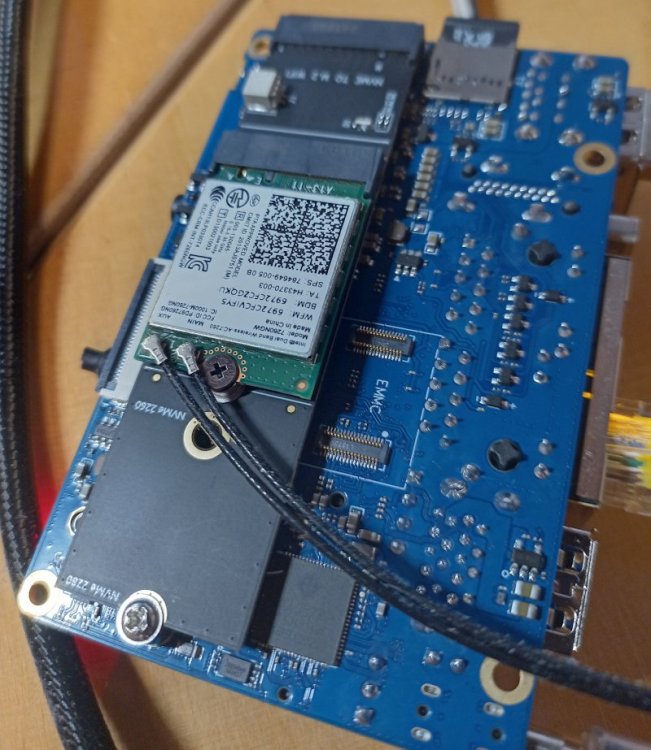All Activity
- Today
-
I use etckeeper on my ODroid-N2. he sends me changes to my /etc/once a day. And regularly I get this change: armbian-leds.conf | 2 +- 1 file changed, 1 insertion(+), 1 deletion(-) diff --git a/armbian-leds.conf b/armbian-leds.conf index 8108230..537ea6f 100644 --- a/armbian-leds.conf +++ b/armbian-leds.conf @@ -5,5 +5,5 @@ invert=0 [/sys/class/leds/rtw88-1-1.1:1.0] trigger=phy0tpt -brightness=1 +brightness=0 What is this mess? What is it for?
-
If anyone wants to make an image for the v1.1 board I dumped the bootloader from the v1.1 board which can be found here: https://www.mediafire.com/file/v41ojct50vqnbbp/bootloader-dump.bin/file
-
update armbian dts ,Give to those in need use sudo armbian-add-overlay ***.dts this dts can avaible rtl8211f on h618 /dts-v1/; /plugin/; / { compatible = "allwinner,sun50i-h618"; fragment@0 { target = <&mmc1>; __overlay__ { status = "disabled"; }; }; fragment@1 { target = <&emac1>; __overlay__ { status = "disabled"; }; }; fragment@2 { target = <&pio>; __overlay__ { x98h_rgmii_pins: x98h-rgmii-pins { pins = "PI0", "PI1", "PI2", "PI3", "PI4", "PI5", "PI6", "PI7", "PI8", "PI9", "PI10", "PI11", "PI12", "PI13", "PI14", "PI15"; function = "emac0"; drive-strength = <40>; }; }; }; /* 3. 配置千兆网卡 */ fragment@3 { target = <&emac0>; __overlay__ { pinctrl-names = "default"; pinctrl-0 = <&x98h_rgmii_pins>; phy-mode = "rgmii"; phy-handle = <&rgmii_phy>; phy-io-supply = <®_aldo1>; allwinner,tx-delay-ps = <700>; allwinner,rx-delay-ps = <3100>; status = "okay"; mdio { rgmii_phy: ethernet-phy@1 { compatible = "ethernet-phy-ieee802.3-c22"; reg = <1>; reset-gpios = <&pio 8 16 1>; reset-assert-us = <30000>; reset-deassert-us = <150000>; }; }; }; }; };
-
https://drive.google.com/drive/folders/1dx0TApPAEjFDz24Rm22J4jgtIbJrYYHC?usp=drive_link build log: url for test...
-
Hi @Nick A, I seem to have the same x96q v5.1 board as @Trauma. He reported some time ago that your x98h image runs as intended on the x96q v5.1 board if the following patch is applied: https://github.com/sicXnull/armbian-build/blob/333e462466670e9a8609771ccd05977b87800881/patch/u-boot/u-boot-sunxi/board_x96q-v5-1/sunxi_mmc-dec-f_max-to-12MHz-to-get-emmc-reliable.patch Although the v5.1 image from @sicxnull does work as well including ethernet and wifi, I would also prefer the more recent armbian version. Can you briefly explain the steps necessary to build a corresponding image for the x96q v5.1? Thank you
- Yesterday
-

The Rock Pi S completely freezes during OOMs
brentr replied to solaris3308's topic in Radxa Rock Pi S
This looks like normal OOM behavior to me. If you want me to replicate, please provide a list of packages to apt install and the commands I need to run to start the passmark benchmark as you did. -
When running PassMark on my Rock Pi S running Armbian 25.11, the system completely freezes, including the serial console. The blue TF card read/write LED stays lit, and OOM events are visible on the serial console. This freeze typically lasts over half an hour before the system recovers as the blue LED turns off. OOM events also occur on the stock kernel 4.4 system, but it doesn't freeze. I really don't want to use the 4.4 kernel system, but how can I optimize it? Below is my system configuration and log output: Translated with DeepL.com (free version) pi@Pi-s:~$ uname -a Linux Pi-s 6.12.58-current-rockchip64 #3 SMP PREEMPT Thu Nov 13 20:34:41 UTC 2025 aarch64 GNU/Linux pi@Pi-s:~$ cat /etc/os-release PRETTY_NAME="Armbian 25.11.2 trixie" NAME="Debian GNU/Linux" VERSION_ID="13" VERSION="13 (trixie)" VERSION_CODENAME=trixie DEBIAN_VERSION_FULL=13.2 ID=debian HOME_URL="https://www.armbian.com" SUPPORT_URL="https://forum.armbian.com" BUG_REPORT_URL="https://www.armbian.com/bugs" ARMBIAN_PRETTY_NAME="Armbian 25.11.2 trixie" ===befor run passmark======== pi@Pi-s:~$ free -h total used free shared buff/cache available Mem: 466Mi 116Mi 145Mi 328Ki 215Mi 350Mi Swap: 233Mi 20Mi 212Mi ==running passmark========== pi@Pi-s:~$ [ 672.734497] systemd-journal invoked oom-killer: gfp_mask=0x140cca(GFP_HIGHUSER_MOVABLE|__GFP_COMP), order=0, oom_score_adj=-250 [ 672.735618] CPU: 2 UID: 0 PID: 388 Comm: systemd-journal Not tainted 6.12.58-current-rockchip64 #3 [ 672.735638] Hardware name: Radxa ROCK Pi S (DT) [ 672.735645] Call trace: [ 672.735650] dump_backtrace+0x94/0x114 [ 672.735670] show_stack+0x18/0x24 [ 672.735679] dump_stack_lvl+0x78/0x90 [ 672.735692] dump_stack+0x18/0x24 [ 672.735700] dump_header+0x40/0x1a8 [ 672.735715] oom_kill_process+0x130/0x358 [ 672.735727] out_of_memory+0xdc/0x568 [ 672.735738] __alloc_pages_noprof+0xcbc/0xdcc [ 672.735752] alloc_pages_mpol_noprof+0x88/0x23c [ 672.735762] alloc_pages_noprof+0x48/0xc0 [ 672.735770] folio_alloc_noprof+0x14/0x64 [ 672.735778] filemap_alloc_folio_noprof+0x140/0x154 [ 672.735789] __filemap_get_folio+0x208/0x394 [ 672.735799] filemap_fault+0x54c/0x858 [ 672.735809] __do_fault+0x3c/0x134 [ 672.735821] __handle_mm_fault+0x9e4/0x17cc [ 672.735831] handle_mm_fault+0xe8/0x2e4 [ 672.735839] do_page_fault+0x100/0x58c [ 672.735851] do_translation_fault+0xac/0xc8 [ 672.735860] do_mem_abort+0x44/0x94 [ 672.735873] el0_da+0x2c/0x9c [ 672.735883] el0t_64_sync_handler+0xe4/0x158 [ 672.735893] el0t_64_sync+0x190/0x194 [ 672.735904] Mem-Info: [ 672.745515] active_anon:9385 inactive_anon:40818 isolated_anon:0 [ 672.745515] active_file:662 inactive_file:777 isolated_file:0 [ 672.745515] unevictable:0 dirty:0 writeback:0 [ 672.745515] slab_reclaimable:3237 slab_unreclaimable:8655 [ 672.745515] mapped:65 shmem:7 pagetables:779 [ 672.745515] sec_pagetables:0 bounce:0 [ 672.745515] kernel_misc_reclaimable:0 [ 672.745515] free:1597 free_pcp:34 free_cma:1 [ 672.748854] Node 0 active_anon:123756kB inactive_anon:77056kB active_file:2736kB inactive_file:2428kB unevictable:0kB isolated(anon):0kB isolated(file):0kB mapped:260kB dirty:0kB writeback:0kB shmem:28kB shmem_thp:0kB shmem_pmdmapped:0kB anon_thp:0kB writeback_tmp:0kB kernel_stack:2144kB pagetables:3116kB sec_pagetables:0kB all_unreclaimable? no [ 672.751655] Node 0 DMA free:6336kB boost:0kB min:2684kB low:3352kB high:4020kB reserved_highatomic:0KB active_anon:38576kB inactive_anon:162236kB active_file:3244kB inactive_file:2308kB unevictable:0kB writepending:0kB present:522240kB managed:477808kB mlocked:0kB bounce:0kB free_pcp:436kB local_pcp:0kB free_cma:68kB [ 672.754668] lowmem_reserve[]: 0 0 0 0 [ 672.755060] Node 0 DMA: 653*4kB (UMEC) 164*8kB (UMEC) 90*16kB (UE) 13*32kB (UE) 5*64kB (E) 4*128kB (E) 0*256kB 0*512kB 0*1024kB 0*2048kB 0*4096kB = 6612kB [ 672.756372] Node 0 hugepages_total=0 hugepages_free=0 hugepages_surp=0 hugepages_size=1048576kB [ 672.757147] Node 0 hugepages_total=0 hugepages_free=0 hugepages_surp=0 hugepages_size=32768kB [ 672.758033] Node 0 hugepages_total=0 hugepages_free=0 hugepages_surp=0 hugepages_size=2048kB [ 672.758825] Node 0 hugepages_total=0 hugepages_free=0 hugepages_surp=0 hugepages_size=64kB [ 672.759562] 1693 total pagecache pages [ 672.762567] 243 pages in swap cache [ 672.762925] Free swap = 212kB [ 672.763223] Total swap = 238900kB [ 672.763550] 130560 pages RAM [ 672.763816] 0 pages HighMem/MovableOnly [ 672.764163] 11108 pages reserved [ 672.764453] 4096 pages cma reserved [ 672.764770] Tasks state (memory values in pages): [ 672.768270] [ pid ] uid tgid total_vm rss rss_anon rss_file rss_shmem pgtables_bytes swapents oom_score_adj name [ 672.769454] [ 233] 990 233 5947 81 32 49 0 94208 640 0 systemd-resolve [ 672.770505] [ 234] 988 234 23067 16 0 16 0 81920 256 0 systemd-timesyn [ 672.771532] [ 242] 0 242 8746 96 32 64 0 86016 512 -1000 systemd-udevd [ 672.772547] [ 264] 998 264 6903 236 64 172 0 90112 320 0 systemd-network [ 672.773662] [ 369] 0 369 4570 32 32 0 0 77824 384 0 wpa_supplicant [ 672.774698] [ 388] 0 388 6833 67 32 0 35 81920 256 -250 systemd-journal [ 672.775746] [ 484] 100 484 1445 92 32 60 0 53248 32 0 avahi-daemon [ 672.776772] [ 488] 0 488 2520 32 32 0 0 49152 32 0 cron [ 672.777768] [ 491] 996 491 2064 93 32 61 0 53248 160 -900 dbus-daemon [ 672.778778] [ 518] 0 518 55049 180 96 84 0 73728 96 0 rsyslogd [ 672.779770] [ 519] 0 519 4682 38 32 6 0 81920 256 0 systemd-logind [ 672.780831] [ 544] 100 544 1414 50 6 44 0 53248 32 0 avahi-daemon [ 672.787179] [ 735] 0 735 4358 114 64 50 0 77824 224 0 wpa_supplicant [ 672.788241] [ 787] 0 787 2701 62 0 62 0 49152 32 0 agetty [ 672.789295] [ 788] 0 788 3775 58 0 58 0 65536 128 0 login [ 672.790457] [ 797] 0 797 2863 115 64 51 0 57344 224 -1000 sshd [ 672.793417] [ 1322] 1000 1322 5625 72 32 40 0 81920 512 100 systemd [ 672.794428] [ 1324] 1000 1324 5942 63 2 61 0 77824 384 100 (sd-pam) [ 672.795407] [ 1333] 1000 1333 3109 422 416 6 0 61440 288 0 bash [ 672.796355] [ 1510] 0 1510 5345 186 128 58 0 90112 288 0 sshd-session [ 672.798743] [ 1514] 0 1514 5346 466 416 50 0 77824 32 0 sshd-session [ 672.804912] [ 1928] 1000 1928 5375 211 164 47 0 90112 352 0 sshd-session [ 672.806021] [ 1929] 1000 1929 5410 449 359 90 0 81920 128 0 sshd-session [ 672.813315] [ 1930] 1000 1930 605 75 0 75 0 45056 32 0 sftp-server [ 672.814361] [ 1931] 1000 1931 3042 103 32 71 0 53248 544 0 bash [ 672.815311] [ 2008] 1000 2008 8691 64 64 0 0 106496 384 0 passmark [ 672.816290] [ 2023] 1000 2023 35734 15887 15887 0 0 315392 11584 0 passmark [ 672.827360] [ 2024] 1000 2024 31575 7416 7416 0 0 278528 15904 0 passmark [ 672.828805] [ 2025] 1000 2025 35734 17441 17441 0 0 315392 10016 0 passmark [ 672.831389] [ 2026] 1000 2026 31839 7873 7864 9 0 282624 15680 0 passmark [ 672.832430] oom-kill:constraint=CONSTRAINT_NONE,nodemask=(null),cpuset=/,mems_allowed=0,global_oom,task_memcg=/user.slice/user-1000.slice/session-8.scope,task=passmark,pid=2023,uid=1000 [ 672.834281] Out of memory: Killed process 2023 (passmark) total-vm:142936kB, anon-rss:63548kB, file-rss:0kB, shmem-rss:0kB, UID:1000 pgtables:308kB oom_score_adj:0 [ 673.170919] systemd-journald[388]: Under memory pressure, flushing caches. pi@Pi-s:~$ pi@Pi-s:~$ pi@Pi-s:~$ [ 1406.871962] systemd-journald[388]: Under memory pressure, flushing caches. pi@Pi-s:~$ [ 1686.724826] systemd-journald[388]: Under memory pressure, flushing caches. [ 2073.973035] systemd-resolve invoked oom-killer: gfp_mask=0x140cca(GFP_HIGHUSER_MOVABLE|__GFP_COMP), order=0, oom_score_adj=0 [ 2073.975522] CPU: 2 UID: 990 PID: 233 Comm: systemd-resolve Not tainted 6.12.58-current-rockchip64 #3 [ 2073.975558] Hardware name: Radxa ROCK Pi S (DT) [ 2073.975564] Call trace: [ 2073.975569] dump_backtrace+0x94/0x114 [ 2073.975591] show_stack+0x18/0x24 [ 2073.975600] dump_stack_lvl+0x78/0x90 [ 2073.975612] dump_stack+0x18/0x24 [ 2073.975620] dump_header+0x40/0x1a8 [ 2073.975634] oom_kill_process+0x130/0x358 [ 2073.975645] out_of_memory+0xdc/0x568 [ 2073.975656] __alloc_pages_noprof+0xcbc/0xdcc [ 2073.975671] alloc_pages_mpol_noprof+0x88/0x23c [ 2073.975681] alloc_pages_noprof+0x48/0xc0 [ 2073.975689] folio_alloc_noprof+0x14/0x64 [ 2073.975697] filemap_alloc_folio_noprof+0x140/0x154 [ 2073.975707] __filemap_get_folio+0x208/0x394 [ 2073.975717] filemap_fault+0x54c/0x858 [ 2073.975727] __do_fault+0x3c/0x134 [ 2073.975740] __handle_mm_fault+0x9e4/0x17cc [ 2073.975749] handle_mm_fault+0xe8/0x2e4 [ 2073.975758] do_page_fault+0x100/0x58c [ 2073.975769] do_translation_fault+0xac/0xc8 [ 2073.975778] do_mem_abort+0x44/0x94 [ 2073.975790] el0_da+0x2c/0x9c [ 2073.975800] el0t_64_sync_handler+0xe4/0x158 [ 2073.975809] el0t_64_sync+0x190/0x194 [ 2073.975821] Mem-Info: [ 2073.988269] active_anon:20576 inactive_anon:36197 isolated_anon:0 [ 2073.988269] active_file:35 inactive_file:317 isolated_file:0 [ 2073.988269] unevictable:0 dirty:0 writeback:0 [ 2073.988269] slab_reclaimable:3159 slab_unreclaimable:8656 [ 2073.988269] mapped:132 shmem:61 pagetables:814 [ 2073.988269] sec_pagetables:0 bounce:0 [ 2073.988269] kernel_misc_reclaimable:0 [ 2073.988269] free:2209 free_pcp:8 free_cma:0 [ 2073.995887] Node 0 active_anon:147140kB inactive_anon:79952kB active_file:328kB inactive_file:1060kB unevictable:0kB isolated(anon):0kB isolated(file):0kB mapped:524kB dirty:0kB writeback:0kB shmem:244kB shmem_thp:0kB shmem_pmdmapped:0kB anon_thp:0kB writeback_tmp:0kB kernel_stack:2208kB pagetables:3256kB sec_pagetables:0kB all_unreclaimable? no [ 2073.999317] Node 0 DMA free:8424kB boost:0kB min:2684kB low:3352kB high:4020kB reserved_highatomic:0KB active_anon:146860kB inactive_anon:80232kB active_file:100kB inactive_file:1224kB unevictable:0kB writepending:0kB present:522240kB managed:477808kB mlocked:0kB bounce:0kB free_pcp:492kB local_pcp:64kB free_cma:72kB [ 2074.004391] lowmem_reserve[]: 0 0 0 0 [ 2074.004781] Node 0 DMA: 8*4kB (U) 282*8kB (UE) 137*16kB (UE) 57*32kB (UE) 16*64kB (UE) 4*128kB (E) 1*256kB (E) 0*512kB 0*1024kB 0*2048kB 0*4096kB = 8096kB [ 2074.006154] Node 0 hugepages_total=0 hugepages_free=0 hugepages_surp=0 hugepages_size=1048576kB [ 2074.006944] Node 0 hugepages_total=0 hugepages_free=0 hugepages_surp=0 hugepages_size=32768kB [ 2074.007692] Node 0 hugepages_total=0 hugepages_free=0 hugepages_surp=0 hugepages_size=2048kB [ 2074.008434] Node 0 hugepages_total=0 hugepages_free=0 hugepages_surp=0 hugepages_size=64kB [ 2074.009158] 1165 total pagecache pages [ 2074.009493] 727 pages in swap cache [ 2074.010642] Free swap = 232kB [ 2074.010949] Total swap = 238900kB [ 2074.011247] 130560 pages RAM [ 2074.011508] 0 pages HighMem/MovableOnly [ 2074.011847] 11108 pages reserved [ 2074.012135] 4096 pages cma reserved [ 2074.012444] Tasks state (memory values in pages): [ 2074.012859] [ pid ] uid tgid total_vm rss rss_anon rss_file rss_shmem pgtables_bytes swapents oom_score_adj name [ 2074.015540] [ 233] 990 233 5918 65 64 1 0 94208 640 0 systemd-resolve [ 2074.016593] [ 234] 988 234 23036 23 0 23 0 81920 256 0 systemd-timesyn [ 2074.017652] [ 242] 0 242 8713 162 128 34 0 86016 370 -1000 systemd-udevd [ 2074.018665] [ 264] 998 264 6903 174 64 110 0 90112 320 0 systemd-network [ 2074.019686] [ 369] 0 369 4570 39 32 7 0 77824 384 0 wpa_supplicant [ 2074.020739] [ 388] 0 388 6793 176 96 13 67 81920 192 -250 systemd-journal [ 2074.021841] [ 484] 100 484 1445 52 32 20 0 53248 32 0 avahi-daemon [ 2074.022857] [ 488] 0 488 2520 32 32 0 0 49152 32 0 cron [ 2074.023800] [ 491] 996 491 2064 110 64 46 0 53248 128 -900 dbus-daemon [ 2074.024797] [ 518] 0 518 55049 115 96 19 0 73728 96 0 rsyslogd [ 2074.025805] [ 519] 0 519 4642 65 32 33 0 77824 224 0 systemd-logind [ 2074.026837] [ 544] 100 544 1414 50 6 44 0 53248 32 0 avahi-daemon [ 2074.027842] [ 735] 0 735 4358 64 64 0 0 77824 224 0 wpa_supplicant [ 2074.028858] [ 787] 0 787 2701 62 0 62 0 49152 32 0 agetty [ 2074.031960] [ 788] 0 788 3775 58 0 58 0 65536 128 0 login [ 2074.033044] [ 797] 0 797 2863 115 64 51 0 57344 224 -1000 sshd [ 2074.034056] [ 1322] 1000 1322 5625 72 32 40 0 81920 512 100 systemd [ 2074.035032] [ 1324] 1000 1324 5942 63 2 61 0 77824 384 100 (sd-pam) [ 2074.035999] [ 1333] 1000 1333 3109 453 416 37 0 61440 288 0 bash [ 2074.036933] [ 1510] 0 1510 5345 90 32 58 0 90112 352 0 sshd-session [ 2074.038232] [ 1514] 0 1514 5346 466 416 50 0 77824 32 0 sshd-session [ 2074.039257] [ 1928] 1000 1928 5375 115 68 47 0 90112 416 0 sshd-session [ 2074.040253] [ 1929] 1000 1929 5410 449 359 90 0 81920 128 0 sshd-session [ 2074.041245] [ 1930] 1000 1930 605 75 0 75 0 45056 32 0 sftp-server [ 2074.042259] [ 1931] 1000 1931 3042 103 32 71 0 53248 544 0 bash [ 2074.043190] [ 2008] 1000 2008 8691 78 64 14 0 106496 384 0 passmark [ 2074.044364] [ 2024] 1000 2024 41346 18840 18840 0 0 360448 14272 0 passmark [ 2074.045725] [ 2025] 1000 2025 47783 14691 14657 34 0 413696 24832 0 passmark [ 2074.047090] [ 2026] 1000 2026 43327 20702 20664 38 0 376832 14400 0 passmark [ 2074.048376] [ 2036] 0 2036 2632 63 32 31 0 49152 37 0 cron [ 2074.049351] [ 2044] 0 2044 2632 2 0 2 0 49152 37 0 cron [ 2074.050395] [ 2053] 0 2053 2520 47 0 47 0 45056 37 0 cron [ 2074.051675] [ 2054] 0 2054 2520 1 0 1 0 45056 37 0 cron [ 2074.052650] oom-kill:constraint=CONSTRAINT_NONE,nodemask=(null),cpuset=/,mems_allowed=0,global_oom,task_memcg=/user.slice/user-1000.slice/session-8.scope,task=passmark,pid=2025,uid=1000 [ 2074.054345] Out of memory: Killed process 2025 (passmark) total-vm:191132kB, anon-rss:58628kB, file-rss:136kB, shmem-rss:0kB, UID:1000 pgtables:404kB oom_score_adj:0 [ 2074.573529] systemd-journald[388]: Under memory pressure, flushing caches. ==== passmark frozen also (run from ssh)========== PassMark PerformanceTest Linux (11.0.1004) Radxa ROCK Pi S Cortex-A35 (aarch64) 4 cores @ 1296 MHz | 466 MiB RAM Number of Processes: 4 | Test Iterations: 1 | Test Duration: Medium -------------------------------------------------------------------------------- CPU Mark: Incomplete Integer Math 0.0 Million Operations/s Floating Point Math 0.0 Million Operations/s Prime Numbers 0.0 Million Primes/s Sorting 0.0 Thousand Strings/s Encryption 0.0 MB/s Compression 0.0 KB/s CPU Single Threaded 0.0 Million Operations/s Physics 0.0 Frames/s Extended Instructions (NEON) 0.0 Million Matrices/s Memory Mark: Incomplete Database Operations Running (1/1) Memory Read Cached Queued Memory Read Uncached Queued Memory Write Queued Available RAM Queued Memory Latency Queued Memory Threaded Queued -------------------------------------------------------------------------------- Results not submitted Use ESC or CTRL-C to exit A: Run All Tests 😄 Run CPU Tests M: Run Memory Tests U: Upload Test Results
-

OZPI v1 new image with Armbian v26.2 Debian stable (trixie)
TRay replied to TRay's topic in Allwinner sunxi
I've been trying to update the system for 2 days but I can't: sudo apt update Get:1 http://deb.debian.org/debian trixie InRelease [140 kB] Get:2 http://security.debian.org trixie-security InRelease [43.4 kB] Get:4 http://security.debian.org trixie-security/main armhf Packages [88.5 kB] Get:5 https://github.armbian.com/configng stable InRelease [5,467 B] Get:6 https://github.armbian.com/configng stable/main armhf Packages [434 B] Get:3 http://armbian.lv.auroradev.org/beta trixie InRelease [39.4 kB] Get:7 http://armbian.lv.auroradev.org/beta trixie/trixie-desktop all Packages [731 B] Get:8 http://armbian.lv.auroradev.org/beta trixie/trixie-desktop armhf Packages [2,250 B] Get:9 http://armbian.lv.auroradev.org/beta trixie/trixie-utils armhf Packages [8,303 B] Ign:9 http://armbian.lv.auroradev.org/beta trixie/trixie-utils armhf Packages Err:9 http://beta.armbian.com trixie/trixie-utils armhf Packages File has unexpected size (10737 != 8303). Mirror sync in progress? [IP: 23.186.113.5 80] Get:10 http://deb.debian.org/debian trixie-updates InRelease [47.3 kB] Get:11 http://deb.debian.org/debian trixie-backports InRelease [54.0 kB] Err:9 http://beta.armbian.com trixie/trixie-utils armhf Packages File has unexpected size (10737 != 8303). Mirror sync in progress? [IP: 23.186.113.5 80] Get:12 http://armbian.lv.auroradev.org/beta trixie/trixie-utils all Packages [3,343 B] Ign:12 http://armbian.lv.auroradev.org/beta trixie/trixie-utils all Packages Get:13 http://deb.debian.org/debian trixie/main armhf Packages [12.7 MB] Err:9 http://beta.armbian.com trixie/trixie-utils armhf Packages File has unexpected size (10737 != 8303). Mirror sync in progress? [IP: 23.186.113.5 80] Ign:12 http://beta.armbian.com trixie/trixie-utils all Packages Get:14 http://deb.debian.org/debian trixie/non-free armhf Packages [69.9 kB] Get:15 http://deb.debian.org/debian trixie/contrib armhf Packages [50.6 kB] Get:16 http://deb.debian.org/debian trixie/non-free-firmware armhf Packages [6,685 B] Get:17 http://deb.debian.org/debian trixie-updates/main armhf Packages [5,144 B] Get:18 http://deb.debian.org/debian trixie-backports/non-free armhf Packages [1,520 B] Get:19 http://deb.debian.org/debian trixie-backports/contrib armhf Packages [4,348 B] Get:20 http://deb.debian.org/debian trixie-backports/non-free-firmware armhf Packages [3,856 B] Get:21 http://deb.debian.org/debian trixie-backports/main armhf Packages [130 kB] Fetched 13.4 MB in 18s (754 kB/s) Error: Failed to fetch http://beta.armbian.com/dists/trixie/trixie-utils/binary-armhf/Packages File has unexpected size (10737 != 8303). Mirror sync in progress? [IP: 23.186.113.5 80] Error: Failed to fetch http://beta.armbian.com/dists/trixie/trixie-utils/binary-all/Packages.bz2 File has unexpected size (3942 != 3343). Mirror sync in progress? [IP: 23.186.113.5 80] Error: Some index files failed to download. They have been ignored, or old ones used instead. -
Has anyone figured out an image for a v1.1 box yet?
-
PCIe MSI is not working. At least with an Intel iwlwifi M.2 card. For that reason, I investigated the differences between the Xunlong KY tree and the Armbian Spacemit Tree. B/c loading the "official" 552kb esos.elf seems to work (even if the Ky version is only 104kb) on the OrangePi RV2, I started to backport Xunlong changes to Armbian/Spacemit family. Newer kernel, but no luck with that MSI. There should be a DMA-transfer-complete interrupt at the end of the firmware upload. Card is working in my PC. MSI is working on OpiRV2 with NVME. Current status: board runs with spacemit-family kernel, but some minor Does-Not-Work yet: LED, onboard Wifi+BT and I need to check that special RTL eth... LG // Sven-Ola Edit: Pic it or it didn't happen. RV2 underside with WIfi card.
-
Hi, I programmed the latest image Armbian_26.2.0-trunk.197_Beagley-ai_plucky_vendor_6.12.49_minimal.img.xz on my beagle Y AI, and connected the power and HDMI and inserted a Dell USB HID for keyboard and mouse, but in initial boot I am not able to use the keyboard and due to this not able to configure the device. Any help will be appreciated. Thanks, Ankit
-

Problem building from source code
Daniel Andersen replied to Eric Johnson's topic in Software, Applications, Userspace
It is already an old thread, but if someone stumbles over this situation, that compile.sh breaks at update-binfmt errors, check if qemu-user-binfmt is installed on the host linux system. do: sudo apt install qemu-user-binfmt and you should be fine again. -
Thank you for hints. Curl approach is not working, too big file for request. Here is log file of build which was adviertised to push into pastbin (debug=yes option was passed) log-build-8431ff32-1cf8-4fe6-9eeb-6f46f683c875.log.zip
-
I managed to get a device tree from Android. The veil has been lifted))) android-dtbo_MYD-lt527m-16e2d-180-e-sx.dts
-
Hm interesting. Didn't know this exists. But if it doesn't work I suggest to run a build with also DEBUG=yes set and then share the whole log using the curl command provided at the end. May give some clues if this fails to apply or works as intended.
-
I have took this variable from Here. Actually the first thing I tried to observe is uart logs. But they are very minimalistic like that: U-Boot SPL 2024.01-armbian-2024.01-S866c-P6b16-Ha5c2-V367a-Bb703-R448a (Apr 29 2025 - 02:50:09 +0000) DRAM: 512 MiB Trying to boot from MMC1 It's from offial image from website, but the compiled image on my side has the same logs and effect
-
never heard of that one before. Serial console is enabled by default on all boards (lookup your board manual on where to connect) which also outputs uboot logs while on early boot stage. For increased kernel verbosity set verbositoy to 7 in /boot/armbianEnv.txt
-

Gaming experience with Orange Pi 5 (RK3588) on Armbian
晓飞丁 replied to KhanhDTP's topic in Orange Pi 5
Great! Thanks a lot! I will try it to se if Diablo II can run tonight! -

Gaming experience with Orange Pi 5 (RK3588) on Armbian
KhanhDTP replied to KhanhDTP's topic in Orange Pi 5
You can download dgVoodoo2 from here: https://community.pcgamingwiki.com/files/file/572-dgvoodoo-2/ (Unfortunately, newer versions of dgVoodoo2 won't work with Wine/Proton.) Extract the archive, then copy dgVoodoo2_79_1/MS/x86/d3d9.dll to the game's folder (just like Dxvk). Then, copy the Dxvk's d3d11.dll, dxgi.dll to the game's folder. If done right, you will see that the Dxvk HUD shows the game uses D3D11 API. -
@chris178 I am currently working on a solution. Radxa typically uses rsetup and extlinux.conf to load overlays during boot; however, Armbian uses armbian-config along with boot.cmd and boot.scr. I have decided to use armbian-config to load the overlays instead.
-
http://blog.armbian.com/content/images/2026/01/githubhighlights-2.webpThis week’s Armbian development saw significant kernel upgrades across multiple platforms, including meson64, rockchip64, and UEFI, with several branches bumped to versions 6.18 and 6.19. Notable hardware support enhancements were introduced, such as SPI controller support for Allwinner A523, new board additions like mixtile-core3588e, and improved compatibility for devices including Radxa and Youyeetoo. The build system received stability and performance improvements, featuring parallel repository generation, refined CI scripts, and fixes for repository management in concurrent environments. Kernel configuration updates enabled additional filesystems and tickless idle for mvebu devices. Several patches addressed hardware initialization, network, and desktop issues, while deprecated packages were removed for a leaner build. Overall, the changelog reflects a strong focus on expanding hardware support, refining build infrastructure, and maintaining kernel currency. add allwinner: a523: Support SPI controllers patch series. by @EvilOlaf in armbian/build#9124allow build on forky host. by @amazingfate in armbian/build#9153CI: add watchdog action script and adjust log cleaning parameter. by @igorpecovnik in armbian/build#9147Fix repository management script for parallel execution. by @igorpecovnik in armbian/build#9163fix: replace comm with grep to support uutils coreutils. by @cantalupo555 in armbian/build#9148kernel configs - enable EROFS as module, ditto overlayfs & F2FS. by @tabrisnet in armbian/build#9135kernel: mvebu: enable tickless idle. by @neheb in armbian/build#9139meson64-6.19: de-bork PCIe, again (missed a patch from 6.18). by @rpardini in armbian/build#9151meson64: bump edge to 6.19; current 6.12 -> 6.18. by @EvilOlaf in armbian/build#9069meson64: bump edge to 6.19; current 6.12 -> 6.18 (nonsquash). by @rpardini in armbian/build#9146Missing variable in board config - address JSON matrix warnings. by @igorpecovnik in armbian/build#9144mixtile-core3588e: add board with vendor and edge branches (Joshua Riek + fixes). by @rpardini in armbian/build#9119Modify radxa-e54c board config to fix leds, network and Gnome desktop init.. by @schwar3kat in armbian/build#9111radxa-cubie-a5e: maint and fixes. by @EvilOlaf in armbian/build#9152Remove libfuse2t64 from package list. by @igorpecovnik in armbian/build#9155Repo tools: add parallel repository generation support. by @igorpecovnik in armbian/build#9150Revert few Rabbit's suggestions that broke repository management. by @igorpecovnik in armbian/build#9156rockchip64-6.18: Enable HDMI1 and audio for HDMI0/1 on CM3588-NAS. by @rpardini in armbian/build#9138rockchip64: add edge kernel support for Youyeetoo YY3588. by @SuperKali in armbian/build#9137rockchip64: fix broken patch in 6.18.3, rewrite everything. by @EvilOlaf in armbian/build#9157uefi-all: bump edge to 6.19 (except loong64); legacy 6.6 -> 6.12; current/cloud 6.12 -> 6.18. by @EvilOlaf in armbian/build#9086uefi-loong64-edge: bump to 6.19. by @amazingfate in armbian/build#9149View the full article
-
So the workaround is to set cpu freq max to 1 MHz. I still have to use a ghetto cooler 5000 when running a process that maxes out the CPU. Seems Duo running 10C+ at idle with latest kernel and Noble. I can live with that as long as I know. The default is 1.2 MHz max which runs too hot at 1.3V.
-
Java UIO Java UIO offers robust Java interfaces optimized for Linux Userspace IO, emphasizing high performance. Engineered from scratch, it leverages contemporary kernel APIs, libraries, and cutting-edge code generation methodologies, embodying a state-of-the-art cross-platform solution. Rather than reinventing established paradigms, Java UIO harnesses existing standards, avoiding redundant development commonly observed in other IO libraries. Seamlessly supporting JDK 25 LTS, this framework integrates Project Lombok to streamline code, enhancing readability and conciseness. 🌍 The 32-bit & FFM Reality With Java 25, there is no more support for X86_32, and ARM32 has limited JDKs available. While FFM (Foreign Function & Memory API) is the future, it is not supported on X86_32 or ARM32. For now, JavaUIO moves into the future providing a high-performance path for ARM32, while fully supporting ARM64 and X86_64.
- Last week
-
Just to add, Armbian boots upto systemd and then gets stuck at loading some scripts. This image gives some additional information.











